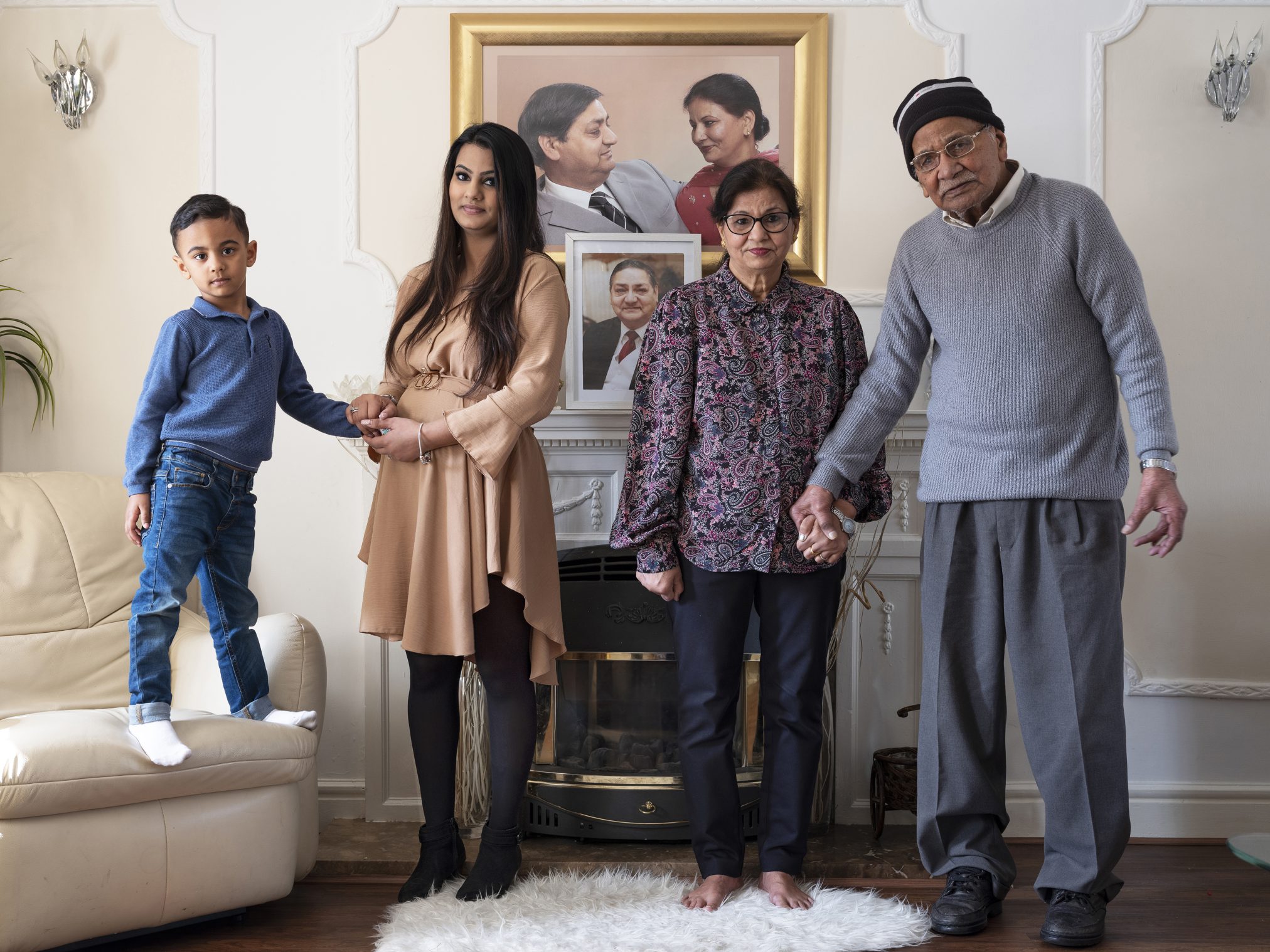GENERATIONS
New writing by Anneka French
Julian Germain’s book The Face of the Century (1999) was published to mark the turn of the millennium through portraits of 100 people arranged by the year of their birth, oldest to youngest. It begins with Lizzie Hutchinson born in 1899 and finishes with newborn baby Rhiannon Germain born in 1999. The captions that accompany each portrait consist of the sitter’s name and year of birth: no more, no less, and because of this, every detail of every portrait assume great importance. The texture of skin, choice of hairstyle or clothes and the expression assumed by each individual are magnified; as fascinating as they are ordinary. Some of the most significant details are those that resist the idea of ‘perfection’: the rain in the hair of Jodie Macdonald b. 1991; the tucked-in collar of Elizabeth Doble b. 1906; Oliver Cook’s runny nose b. 1996; Rhiannon’s calloused top lip, a detail I am especially drawn to since my eldest son had the same feature at the same age. The 100 lives of these people are bound together through the book’s pages; Germain connected them when he invited a random selection of individuals to sit for him. The Face of the Century was published twenty-three years ago, before the pervasiveness of the digital, and nevertheless retains enormous power, largely due to the quality of the portraits but also due to the unique timing and context of the project. There is a good chance that many of these individuals, certainly those who were in their eighties or nineties at the time, are no longer living; the youngest of those photographed will now be adults, part of the so called ‘millennial generation’. What became of each person? What lives they have they since lived and who else’s lives have they touched?
GENERATIONS is an extension and expansion of the research and ideas Germain began with The Face of the Century. Developed by GRAIN Projects in partnership with Multistory as part of Birmingham 2022 Festival, a large-scale cultural programme designed to coincide with the Birmingham 2022 Commonwealth Games, Germain’s focus is this time upon families based in Birmingham and the Black Country that have four or five direct lineage generations. While this is an idea he has been exploring for some fifteen years, this is the first time GENERATIONS has come to this area of the country. Beginning with an open call for families, extensive shoots taking place in people’s homes since November 2021 that centre upon these people as individuals and as integral parts of a complex family structure. Each photograph is shot within the home, with each of those four or five generations arranged in age order, skilfully framed and balanced against the clean lines of a mantelpiece or the softer curves of a sofa or dramatic pair of curtains. The composition of a family is a constellation and inevitably holds multiple tensions and joys within it. Germain is cautious of his work being used to propose an entirely romantic notion of family. He notes that families “have a tremendous hold over our feelings and the connections we make, but as well as being supportive and loving they can sometimes be stifling or dysfunctional too.” Families, are for many of us, relatable and this makes the long exposure photographs that Germain produces rich and compelling. Further, these are documents of this moment in history, cultural and social records of family samples from Birmingham and the Black Country, and the portraits are a recognition of the family unit as something that is greater and more layered than the sum of its parts. GENERATIONS is also an invitation to connect.
In Germain’s GENERATIONS portraits we can trace similarities in facial features, expressions, hairstyles, clothing choices and body language within photographs and across them, finding patterns that bind this group of images together for reasons other than simply circumstance. Jean Ann Perkins and her daughter, granddaughter and great-granddaughter all wear an item of yellow clothing or yellow accessory, for instance, while three of the four generations in Pauline Curtis’ shot wear leopard print clothing and three of the four generations of Herma Hansle’s wear white. Though these may be deliberate choices or serendipity, they reveal something of the connections and synchronicities of thought between these family members as well as something of the fashions and tastes of people within the period of the project. Taken altogether as a body of work, the portraits are indicative of wider global issues, the ubiquitousness of energy smart meters at a time of UK fuel crisis, for example, rooting the photographs in the time of their making. Events from the Beijing Winter Olympics appear on the television in the background of several photographs, with a calendar turned over to March 2022 in Wilbert Francis’ shot. Clocks feature in almost all of them. We understand that tiny details tell larger narratives.
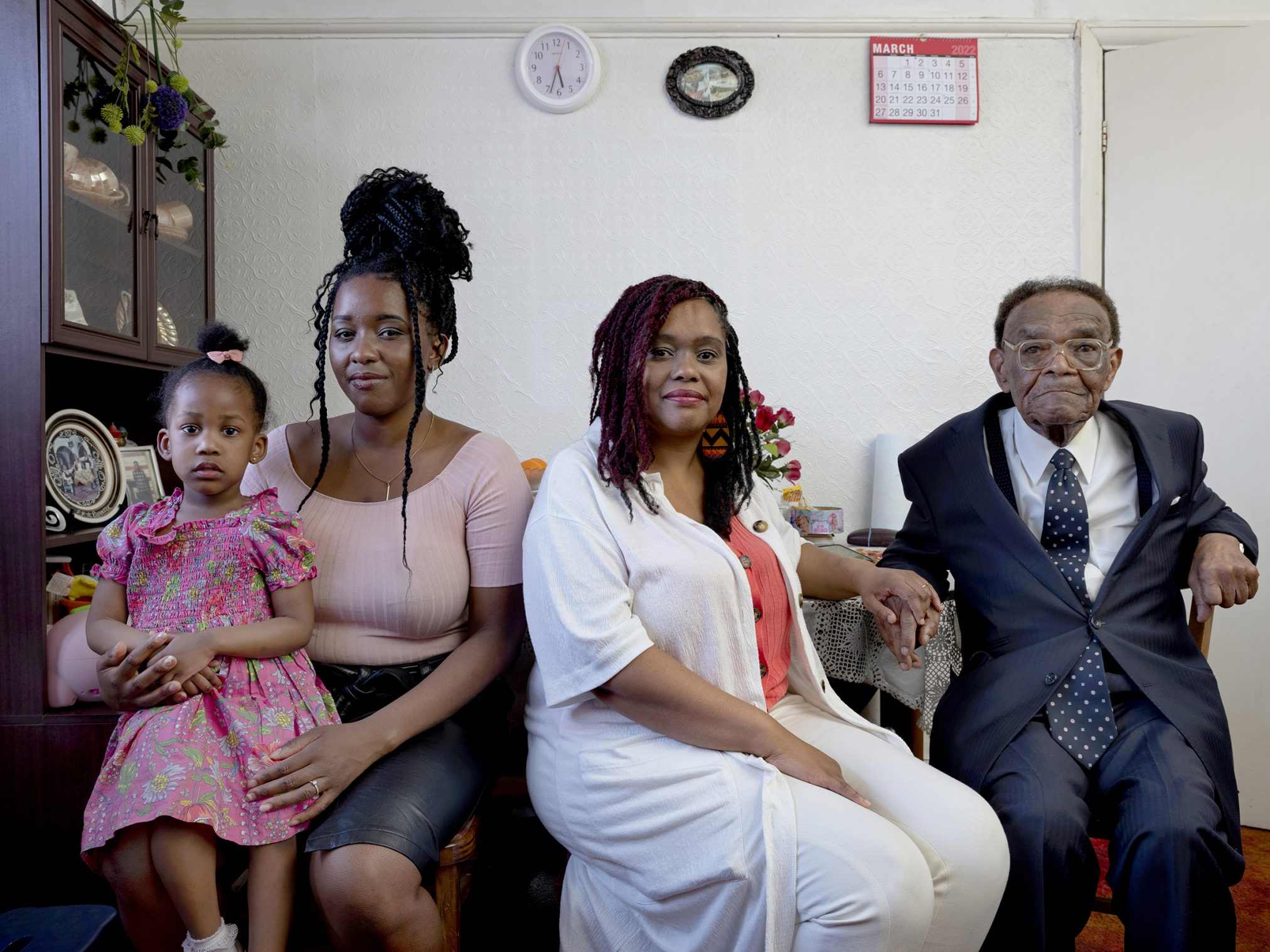
Family dynamics are key throughout and pose and body language feed into this. Formally speaking, the portrait subjects are arranged sitting or standing, often creating a straight horizontal line across the image or in an arc or triangle formation, with central standing figures flanked by seated figures. The physical points of connection between hands, arms, knees, shoulders and laps give the portraits emotional and psychological depth. Many of the younger children of GENERATIONS are balanced on footstools or sofas, elevating them within the frame where adults are standing tall. Reece Sandhu (4) and Rafaella Pulisciano (3) are among those number, boosters a reminder of their physical smallness and hugely important role within their families. Raising children. Another infant who is elevated is one-week old Elliot Price who appears with his identical twin brother Harrison. Elliot’s blue-eyed gaze is at once soft and penetrating as he peers out of his car seat, balanced on a kitchen chair. There are evident links here to Rhiannon in The Face of the Century. A text by Martin Herron written for The Face of the Century notes itis “A book saturated with time … [the photographs] defy interpretation. They are fixed, yet illusive. Right in front of us, yet somewhere in the distance. We cannot see them because their faces are secondary to the gaze, and the gaze obscures our view … This book is a book of secrets … The last image is of a baby. Newborn, unformed – we don’t even know what colour her eyes will be.” GENERATIONS, however, offers us a pretty good guess. Elliot and Harrison’s future selves are foreshadowed; they seem already entirely formed, already the spitting image of not only each other but their father and grandfather, even if their great grandfather’s face is slightly different. Germain tells me that it was the twins’ mother’s birthday when the photograph was taken: it is her birthday cake on the right of the image. Their mother is outside the photograph’s frame, outside of Germain’s criteria of direct lineage, remaining nonetheless present in the portrait through the inclusion of the cake and through her obvious absence. I hope she is having a little lie down. One-week-old twins and a family photo shoot sound a challenge.
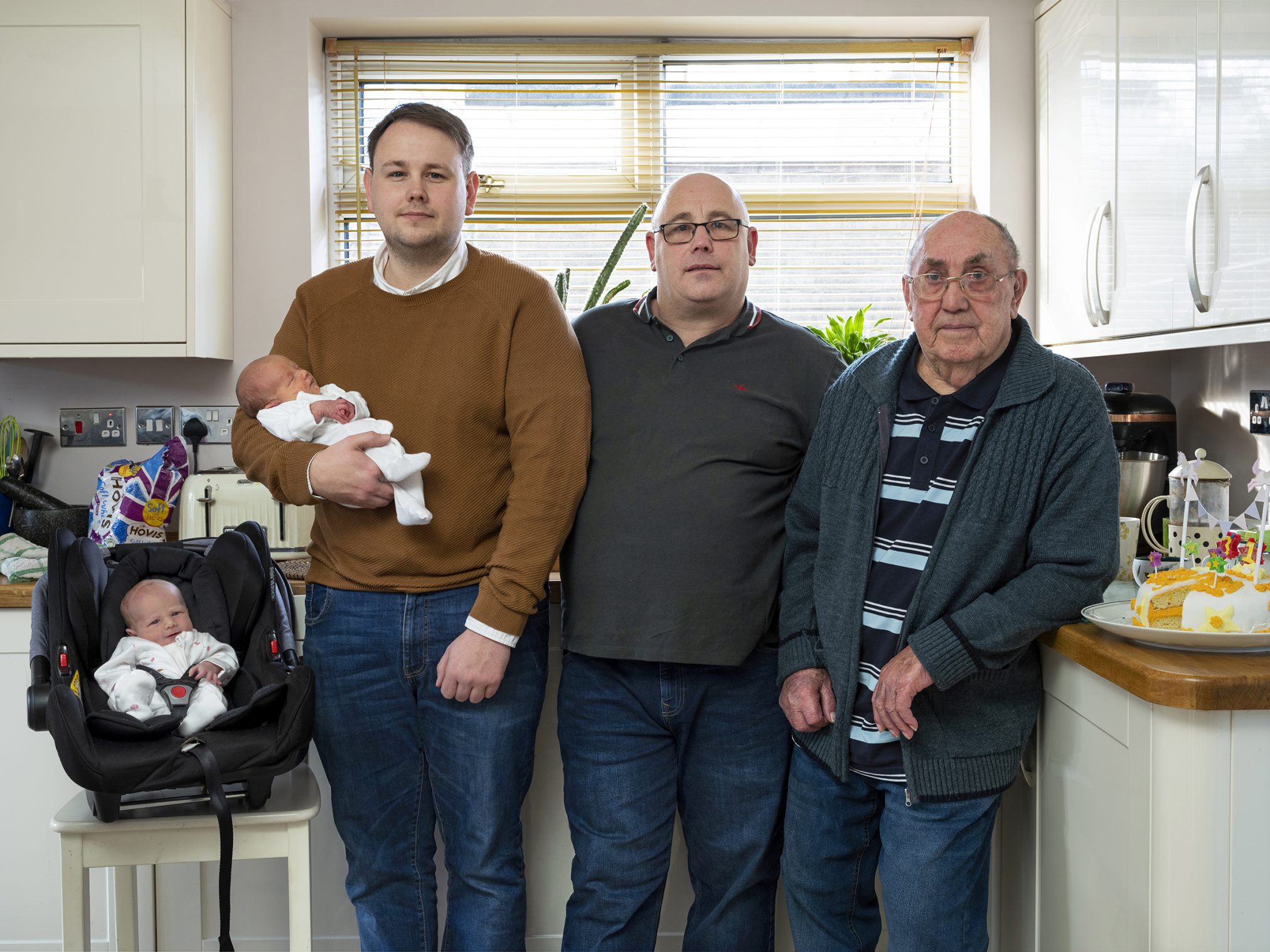
Other of the GENERATIONS photographs find ways to incorporate additional family members too. In the two versions of Adella Peterkin’s images, there are three female adults in shot although what might be an adult male coat and cap appear on wall hooks behind. There are many instances of family photographs (and a drawing or print) visible on walls, mantelpieces, shelves and in pride of place on pieces of furniture. Family photos are arguably the most precious items that many of us hold. Those included here may show those in the portrait itself at different or similar stages in their lives although as viewers we may equally be gaining insight into other members of the family who did not participate in the shoot. Arguably, speaking almost as loudly from each portrait are the voices of those that are not in the photograph’s frame – other siblings, family formed through marriage, civil partnership, friendships, stepfamilies, adopted families, foster families, those who were working or travelling at the time of Germain’s visit, those who have not yet been born those who did not meet Germain’s criteria, those unwell or those who have died. Objects –sometimes kept in their original position or moved to a new position in a room for the shoot – contain huge narrative and symbolic potential. A statue of an angel by the feet of the women in Jean Ann Perkins’ portrait, for instance, appears to refer to missing loved ones; a pair of discarded pink glittery shoes might belong to her great granddaughter Imogen or to another child entirely that we cannot see. A clock and the word ‘time’ appears over Prudence Whittingham’s family on the wall behind them; Germain has cropped the decal butterflies so that they drift out of the photograph’s frame. Both lend this image a sad poignance. The open door on the right is indicative of hope, loss, possibility. Striking different notes entirely, we see the strange anthropomorphism of cuddly toys in action, particularly the giraffe wearing a size 5+ nappy belonging to two-year old Lewis Burton. Elsewhere, Oprah Winfrey is the cover star of Platinum magazine, her face humorously prominent in a woven basket close to Maya Rai’s side.

Making comparisons between ourselves and others is both a curse and a blessing, the blessing being that it helps us to make sense, to shape identity and to find the comfort of familiarity. We are social animals deeply rooted to and always searching for community. Indeed, collective memory and a sense of belonging is increasingly urgent in times of crisis, such as the political, climate and health emergencies we are currently experiencing, to name but a few. In Germain’s GENERATIONS portraits we find multiple everyday domestic objects that we can identify with. So too, these objects provide us as viewers with clues as to the interests of the sitters, even down to the specific television programme on in the background or the preference of newspaper tucked down the side of the sofa, as well as additional leisure pursuits suggested by a chess set, piano, collections of books, jigsaws and a hi-fi. There are clues to other members of the family through children’s toys and games, pet accessories, shoes, trophies, anniversary cards and fridge magnets: all objects that point to elsewhere and to other people.
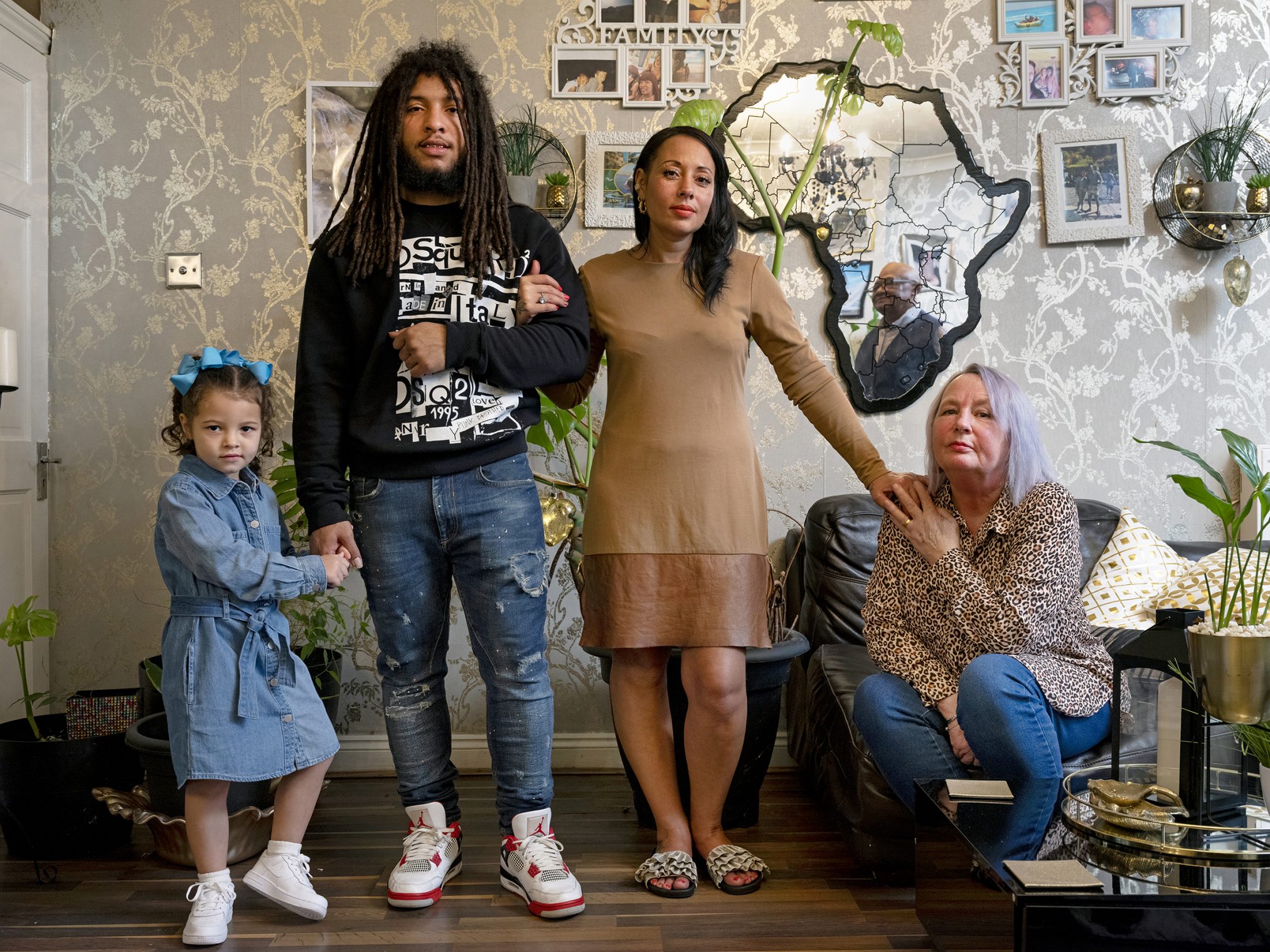
Linda Haughton’s portrait is notable for several reasons. In addition to the four generations standing and the framed family photographs proudly hung on the wall, we find a very large mirror cut in the shape of Africa. Formally, it is dominant and eye-catching, culturally perhaps it infers clues to the family’s heritage, significant in the context of the Commonwealth Games and in the migration stories of Birmingham and the Black Country area. The mirror additionally offers a slightly distorted reflection of another man who is not part of the main portrait group. This almost-hidden reflection puts me in mind of historical paintings made by artists who excelled in making oils that would showcase the wealth or status of their patron’s family, often with explicit or sometimes more subtle symbolism, sometimes incorporating optical illusion. Another remarkable portrait that calls back to art history is that of Enrichietta Caizo and her daughter, grandson and great-granddaughter. I cannot shake the fact that there are so many threads of connection to The Ambassadors, a painting made in 1533 by Hans Holbein the Younger of two French ambassadors, produced in London at a politically turbulent time with Henry VIII on the throne. Both Caizo’s photographic portrait and Holbein’s painted portrait contain globes indicative of the importance of travel (noteworthy, again, in light of the Commonwealth context) and other instruments for measuring intangible phenomena such as time or celestial bodies – an hourglass and a hanging ornament of moon phases, in Caizo’s case. Surrounding Caizo are multiple other objects that feel loaded with symbolism – a doll’s house, toy till, camel statue, cocktail shaker, sports team photograph and a miniature neo-classical male sculpture high up on a shelf – things that might (or might not) be connected to socio-economic and cultural achievement and/or aspiration. Caizo’s imposing, confident pose, tiger-print dress and knee-high leather boots give an impression of power and confidence. She is depicted here as the head of the family. A glimpse of the blue sky and bare tree branches through the roof window of her portrait is again reminiscent of the Western Renaissance trope in which a fragment of landscape behind a portrait sitter(s) would lead the eye elsewhere and contextualise the figure(s), perhaps in an imagined, idealised or specific location.
During each of the thirty family shoots, Germain took time to learn about each family and their stories. He is full of anecdotes that evidence the bonds he has been quickly and adeptly able to make with those he photographs. Part of these conversations took place in front of family photo albums, a way of telling the history of each family tree and its multiple, entangled branches, with Germain uncovering joyful experiences while reflecting on difficulties and challenges in dialogue with those he photographed. Germain describes family album photographs as a way to stretch time. Curator and producer Liz Weiwora’s introduction to the first issue of A Spotlight On, an annual publication from the Socially Engaged Photography Network (SEPN) is titled ‘When to look means to listen’. This sentiment is true in the making of the GENERATIONS photographs, in all their prior logistical organisation and in their reception – in our looking. We must be mindful to try to steer clear of assumptions and to use our eyes to listen as well as look.
GENERATIONS is a present-day archive of family, place and time: a fitting commission by and for the Commonwealth Games. The stories, personalities and memories held within each frame are partial. They can be glimpsed or guessed at via expression, body language, the visibility and frequency of family snaps and other objects positioned in each room. The portraits remain private even as they are extremely public, shown at locations such as advertising billboards and poster sites at train stations around Birmingham and neighbouring Sandwell. The characteristics of the living room, kitchen or conservatory, the collections of objects, choices of décor and display are unique, even as we are invited to and indeed do seek points of connection and familiarity to them. Germain’s photographs are set within the intimacy of the family home, where one, two or more of these generations reside and this special space is one that has assumed far greater significance for many of us since the turmoil of the Covid-19 pandemic and social restrictions. Germain tells me that these portrait shoots were in some cases, the first time these families had gathered since before the pandemic, with older family members visiting from care homes or assisted living spaces. This makes, then, the physical points of connection – a hand clasp, an arm around a waist or shoulder or pairs of knees pressed together all the more valuable and all the more worth capturing for posterity.
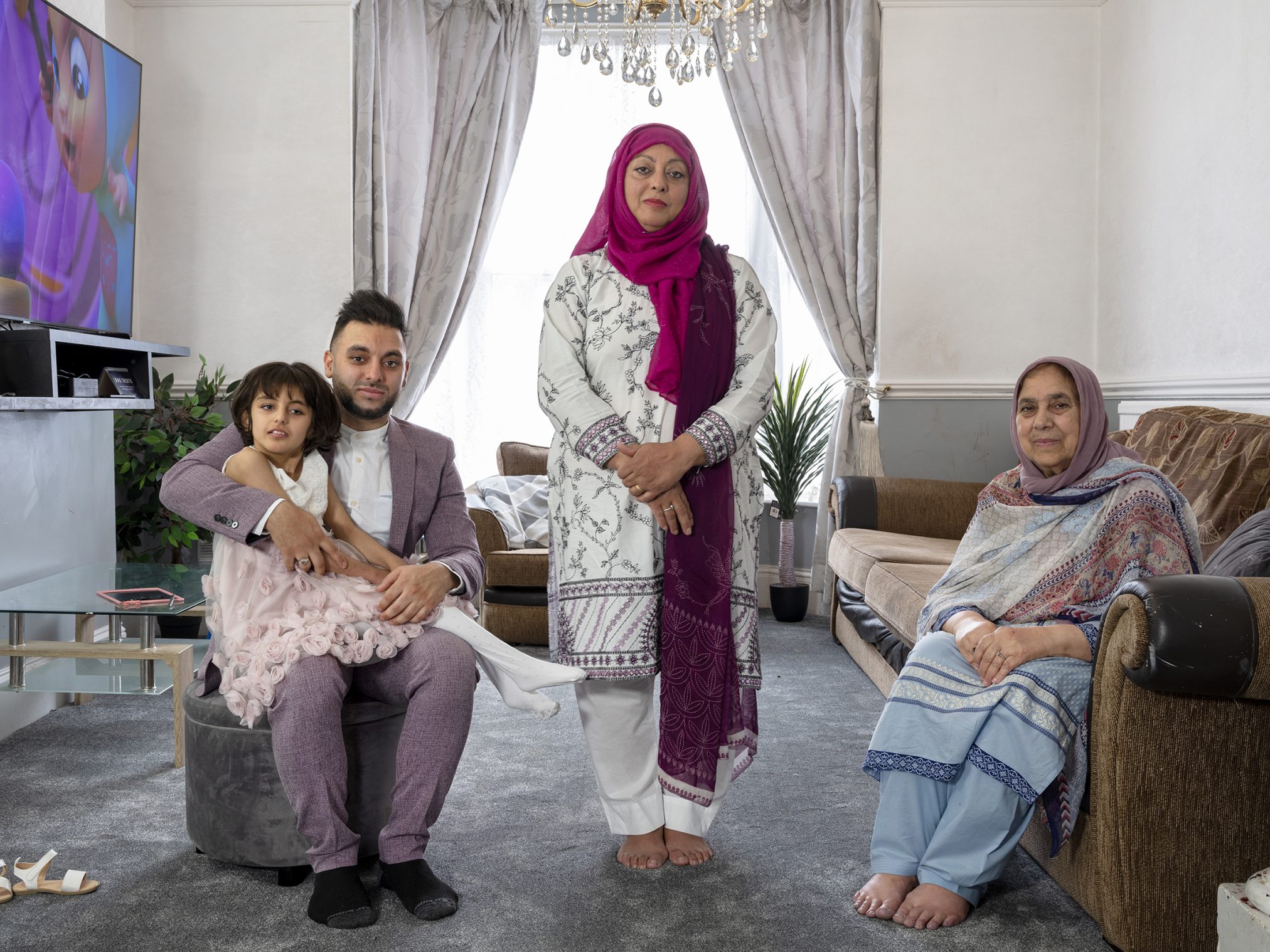
Writing by Anneka French
GENERATIONS is generously supported by Arts Council England and National Heritage Lottery Fund.


